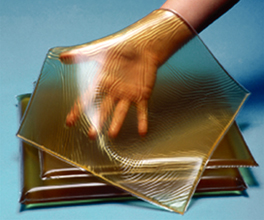Superflab Bolus Material
Superflab bolus material is offered in thicknesses which provide maximum dose build-up for relevant
photon energies. Since the material does not suffer inelastic strain from normal stresses, it does not have to
be bagged or wrapped in plastic film to maintain its shape.
At the option of the user, however, Superflab may be wrapped in disposable plastic film for cleanliness and use, or
it may be washed with soap and water as needed, followed by an application of talcum powder or corn starch.
Superflab slabs are elastic and quite "flabby". The material conforms nicely to the patient's contour while still
maintaining good uniformity of thickness.
The dosimetric properties of Superflab were determined by comparison with polystyrene of various thicknesses, using
both photon and electron beams of various energies. Subsequently, it was compared with water and was found
to be closer to simulation of water than polystyrene.
Since this vinyl gel has both an electron build-up characteristic and a density closer to that of water than
polystyrene (long accepted as a standard), it is anticipated this flexible tissue substitute will find wide
acceptance in radiotherapy departments.
Although Superflab exhibits very little cold flow, it is best stored flat, not folded.
Because Superflab is an oil gel, care must be taken because the synthetic oils can damage plastic
surfaces, particularly vinyl-covered furniture.
Superflab was developed by Gene R. Feaster, Ph.D
